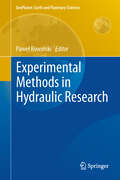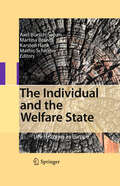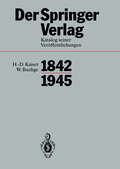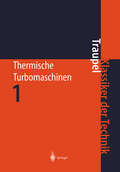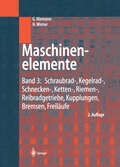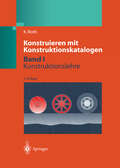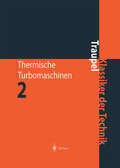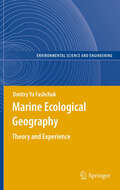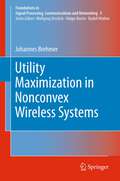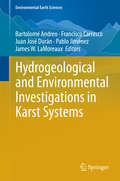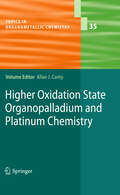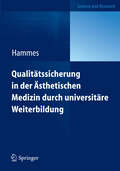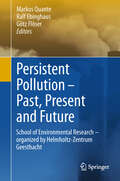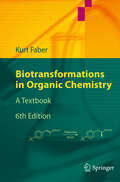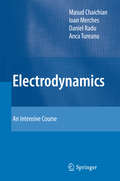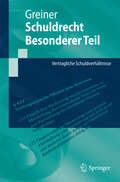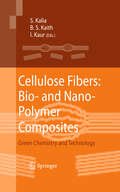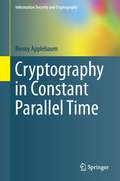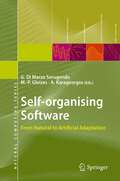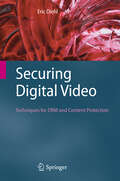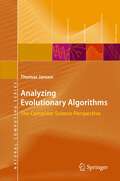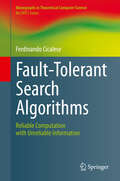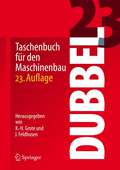- Table View
- List View
Experimental Methods in Hydraulic Research
by Paweł RowińskiIt is clear that hydraulic research is developing beyond traditional civil engineering to satisfy increasing demands in natural hazards assessment and also environmental research. Our ability to describe processes in nature rests on the observation and experimental methods as well as on theoretical basics of various disciplines. Under such conditions experimental methods draw from various areas of human activities and research, i.e. from physics, biology, chemistry, aerospace research, oceanic research etc. The current volume is the result of a meeting that took place during the 30th International School of Hydraulics in Poland and presents both the state-of-the-art and ongoing research projects in which experimental methods play a key role. Authors from numerous leading laboratories and from various countries guarantee a representative sample of different studies at the frontier of the field
The Individual and the Welfare State
by Mathis Schröder Martina Brandt Karsten Hank Axel Börsch-SupanOur health, our income and our social networks at older ages are the consequence of what has happened to us over the course of our lives. The situation at age 50+ reflects our own decisions as well as many environmental factors, especially interventions by the welfare state. This book explores the richness of 28,000 life histories in thirteen European countries, collected as part of the Survey of Health, Ageing and Retirement in Europe (SHARE). Combining these data with a comprehensive account of European welfare state interventions provides a unique opportunity to answer the important public policy questions of our time - how the welfare state affects people's incomes, housing, families, retirement, volunteering and health. The overarching theme of the welfare state creates a book of genuinely interdisciplinary analyses, a valuable resource for economists, gerontologists, historians, political scientists, public health analysts, and sociologists alike.
Der Springer-Verlag
by W. Buchge H. D. Kaiser Heinz SarkowskiEin Katalog der sämtlichen Veröffentlichungen eines Verlags ist die Leistungsbilanz seiner Arbeit und damit auch ein Ausdruck des Dankes gegenüber dem Gründer und den Verlegergene rationen die ihm nachfolgten. Er ist zugleich die objektivste Dokumentation der Geschichte des Verlags, indem er die Pro duktion seit dem Gründungsjahr nach Einzeltiteln registriert. Der Vorschlag, die Veröffentlichungen des Springer-Verlags seit seiner Gründung möglichst vollständig in einem Katalog nachzuweisen, geht auf das Jahr 1978 zurück. Zunächst stieß der Gedanke auf Skepsis, denn Julius Springer hatte in den ersten Jahren seiner Tätigkeit zahlreiche Broschüren veröffentlicht, die nur für den Tag bestimmt waren. Viele von ihnen fehlen schon in den ältesten der erhaltenen Verlagskataloge aus den 1880er Jahren. Manche wurden nicht einmal in den Leipziger Meßkatalogen angezeigt. In Einzelfällen mag dies auch poli tische Vorsicht geboten haben. Erste Recherchen ergaben dann, daß auch für die Zeit des Vormärz eine weitgehende Vollständigkeit zu erreichen war. Julius Springer hatte sich nämlich keineswegs gescheut, seine politischen Schriften im Börsenblatt anzuzeigen. Bei weiteren Nachforschungen konnten dann auch die meisten dieser Schrif ten in Bibliographien der Zeit ermittelt und gelegentlich auch über den Leihverkehr beschafft werden.
Thermische Turbomaschinen
by Walter TraupelDas Werk gibt eine umfassende Darstellung der theoretischen Grundlagen zur Berechnung und Auslegung von Dampfturbinen, Gasturbinen und Turbokompressoren. Der erste Band behandelt die thermodynamische Prozeßführung von Dampf- und Gasturbinenanlagen und die thermodynamisch-strömungstechnische Berechnung der Turbomaschinen selbst. Um zu einem vertieften Verständnis zu führen, wird die Theorie stets aus den Grundwissenschaften heraus entwickelt, weshalb auch ein kurzer Abriß der thermodynamischen und strömungstechnischen Grundlagen an den Anfang gestellt ist.
Maschinenelemente
by Hans Winter Burkhard Neumann Gustav NiemannDas dreibändige Werk Maschinenelemente ist längst zum Standardwerk auf dem Gebiet der Maschinenelemente geworden. Der vorliegende Band 3 bietet Studenten und Praktikern sowohl einen Überblick als auch reichhaltige Detailinformationen über das gesamte Wissensgebiet der Schraubrad-, Kegelrad-, Schnecken-, Ketten-, Riemen-, Reibradgetriebe, Kupplungen, Bremsen und Freiläufe. Auf der Basis einer sorgfältigen Analyse der Funktionen werden Auslegung, Konstruktion und Berechnung von Getrieben und Kupplungen methodisch dargestellt. Dabei werden alle für den Konstrukteur und Ingenieur wichtigen Aussagen über die hier behandelten Maschinenelemente, wie zulässige Spannungen, Reibungszahlen, Konstruktionsdaten oder sonstige Erfahrungswerte, umfassend erläutert. Der klare Aufbau, die Beispiele zu allen Berechnungen sowie die umfangreiche Literaturliste bieten dem Leser besonderen Nutzen.
Konstruieren mit Konstruktionskatalogen
by Karlheinz RothKonstruieren mit Konstruktionskatalogen bedeutet mit systematisch und übersichtlich aufbereiteten technischen, physikalischen und mechanischen Unterlagen zu arbeiten. Band 1: Konstruktionslehre enthält das methodische Vorgehen beim Konstruieren, sowohl ausschließlich diskursiv als auch gekoppelt mit intuitivem Arbeiten, mit oder ohne Rechnerhilfe, und ist auch als Lehrbuch gut einsetzbar.
Thermische Turbomaschinen: Geänderte Betriebsbedingungen, Regelung, Mechanische Probleme, Temperaturprobleme
by Walter TraupelDas Buch behandelt ausführlich das Verhalten der thermischen Turbomaschinen unter geänderten Betriebsbedingungen und darauf aufbauend ihre Regelungseigenschaften. Weiter werden die spezifischen Festigkeitsprobleme der Turbomaschinen dargestellt. Diesen Kapiteln ist ein allgemeines Kapitel über die Grundlagen der Festigkeitsrechnungen vorausgeschickt, das zwar diejenigen Aspekte besonders hervorhebt, die im Turbomaschinenbau vor allem wichtig sind, aber auch für verwandte Gebiete bedeutsam ist, da eine geraffte Darstellung dieser Art bis heute fehlt. Der Bestimmung der Temperaturverteilung in den maßgebenden Konstruktionsteilen (insbes. in der gekühlten Gasturbine) ist ein weiteres Kapitel gewidmet. Den Abschluß bilden die Ausführungen über die Schaufelschwingungen und die lauftechnischen Probleme der Rotoren.
Marine Ecological Geography
by Dmitry Ya FashchukIn Chapter 1 the methodological principles of systemization and visualization of multidimensional ecological information for its operational dissemination among potential users are stated. Their realization results in creation of the geographic-and ecologic model of marine basin as an information base for diagnosis of the marine ecosystem state, estimation of consequences of economic activity, and modelling of its changes with the use of mathematical tools. In Chapter 2 the geographic-and-ecological aspects of mathematical modelling of marine ecosystems, the possibilities and peculiarities of the most adequate models, the Russian hydrodynamic model of oil spills "SPILLMOD" and hydroecological model of organogenic compound transformation in the sea, are investigated. In the following six Chapters the examples of practical realization of geographic-and-ecological (as information source) and mathematical (as computing apparatus) modelling at the investigations of specific ecological problems associated with consequences of natural hazards and economic activity on aquatory and within the whole Black Sea basin are given.
Utility Maximization in Nonconvex Wireless Systems
by Johannes BrehmerThis monograph develops a framework for modeling and solving utility maximization problems in nonconvex wireless systems. The first part develops a model for utility optimization in wireless systems. The model is general enough to encompass a wide array of system configurations and performance objectives. Based on the general model, a set of methods for solving utility maximization problems is developed in the second part of the book. The development is based on a careful examination of the properties that are required for the application of each method. This part focuses on problems whose initial formulation does not allow for a solution by standard methods and discusses alternative approaches. The last part presents two case studies to demonstrate the application of the proposed framework. In both cases, utility maximization in multi-antenna broadcast channels is investigated.
Hydrogeological and Environmental Investigations in Karst Systems
by James W. Lamoreaux Bartolomé Andreo Francisco Carrasco Juan José Durán Pablo JiménezWATER RESOURCES AND ENVIRONMENT provides a detailed introduction to the full range of advanced, multidisciplinary techniques used in the study of water resources from understanding individual aquifers to the protection and management of water in a sustainable way, compatible with the preservation of the environment. Based on a masters course from UNESCO's International Hydrological Program, this textbook is accompanied by color figures and graphics, illustrating clearly the content of the text and showing real examples from the field. Each chapter also contains a list of exercises and practical activities as well as case studies.
Higher Oxidation State Organopalladium and Platinum Chemistry
by Allan J. CantyKyle A. Grice, Margaret L. Scheuermann and Karen I. Goldberg: Five-Coordinate Platinum(IV) Complexes.- Jay A. Labinger and John E. Bercaw: The Role of Higher Oxidation State Species in Platinum-Mediated C-H Bond Activation and Functionalization.- Joy M. Racowski and Melanie S. Sanford: Carbon-Heteroatom Bond-Forming Reductive Elimination from Palladium(IV) Complexes.- Helena C. Malinakova: Palladium(IV) Complexes as Intermediates in Catalytic and Stoichiometric Cascade Sequences Providing Complex Carbocycles and Heterocycles.- Allan J. Canty and Manab Sharma: h1-Alkynyl Chemistry for the Higher Oxidation States of Palladium and Platinum.- David C. Powers and Tobias Ritter: Palladium(III) in Synthesis and Catalysis.- Marc-Etienne Moret: Organometallic Platinum(II) and Palladium(II) Complexes as Donor Ligands for Lewis-Acidic d10 and s2 Centers.
Brain, Behavior and Epigenetics (Epigenetics and Human Health)
by Arturas Petronis Jonathan MillBiomedical research in the first decade of the 21st century has been marked by a rapidly growing interest in epigenetics. The reasons for this are numerous, but primarily it stems from the mounting realization that research programs focused solely on DNA sequence variation, despite their breadth and depth, are unlikely to address all fundamental aspects of human biology. Some questions are evident even to non-biologists. How does a single zygote develop into a complex multicellular organism composed of dozens of different tissues and hundreds of cell types, all genetically identical but performing very different functions? Why do monozygotic twins, despite their stunning external similarities, often exhibit significant differences in personality and predisposition to disease? If environmental factors are solely the cause of such variation, why are similar differences also observed between genetically identical animals housed in a uniform environment? Over the last couple of decades, epigenetics has undergone a significant metamorphosis from an abstract developmental theory to a very dynamic and rapidly developing branch of molecular biology. This volume represents a compilation of our current understanding about the key aspects of epigenetic processes in the brain and their role in behavior. The chapters in this book bring together some of the leading researchers in the field of behavioral epigenetics. They explore many of the epigenetic processes which operate or may be operating to mediate neurobiological functions in the brain and describe how perturbations to these systems may play a key role in mediating behavior and the origin of brain diseases.
Qualitätssicherung in der Ästhetischen Medizin durch universitäre Weiterbildung
by Stefan HammesMit dem Buch werden die Standards für eine interdisziplinäre, universitäre und praxisorientierte Ausbildung in der ästhetischen Lasermedizin definiert. Das Beispiel des ersten Weiterbildungsstudienganges in Deutschland mit dem universitären Abschluss Diploma in Aesthetic Laser Medicine (DALM) zeigt, wie das Risikomanagement in der ästhetischen Medizin konkrete Form annehmen kann. Der Band enthält einen Fragenkatalog zur Vorbereitung auf die Prüfung.
Persistent Pollution – Past, Present and Future
by Götz Flöser Markus Quante Ralf EbinghausThis book evolved from the 5th School of Environmental Research entitled "Persistent Pollution - Past, Present and Future", which has set a focus on Persistent Organic Pollutants (POPs), heavy metals and aerosols. - reconstruction of past changes based on the scientific analysis of natural archives such as ice cores and peat deposits,- evaluation of the present environmental state by the integration of measurements and modelling and the establishment of cause-effect-patterns,- assessment of possible environmental future scenarios including emission and climate change perspectives.
Biotransformations in Organic Chemistry: A Textbook
by Kurt FaberThe use of biocatalysts, employed either as isolated enzymes or whole microbial cells, offers a remarkable arsenal of highly selective transformations for state-of-the-art synthetic organic chemistry. Over the last two decades, this methodology has become an indispensable tool for asymmetric synthesis, not only at the academic level, but also on an industrial scale. This well-established textbook on biocatalysis provides a basis for undergraduate and graduate courses in modern organic chemistry, as well as a condensed introduction into this field. After a basic introduction into the use of biocatalysts--principles of stereoselective transformations, enzyme properties and kinetics--the different types of reactions are explained according to the 'reaction principle', such as hydrolysis, reduction, oxidation, C-C bond formation, etc. Special techniques, such as the use of enzymes in organic solvents, immobilization techniques and modified or artificial enzymes, are treated in a separate section. A final chapter deals with thebasic rules for the safe and practical handling of biocatalysts. In this completely revised 6th edition, emphasis has been given to an improved didactic style including colored graphics in order to facilitate a deeper understanding of the underlying principles. New developments, such as transamination, enzyme promiscuity and applications on industrial scale within the field of 'white biotechnology' are included.
Electrodynamics
by Masud Chaichian Anca Tureanu Ioan Merches Daniel RaduThis book is devoted to the fundamentals of Classical Electrodynamics, one of the most beautiful and productive theories in physics. A general survey on the applicability of physical theories shows that only few theories can be compared to Electrodynamics. Essentially, all electric and electronic devices used around the World are based on the Theory of Electromagnetism. It was Maxwell who created, for the first time, a unified description of the electric and magnetic phenomena in his electromagnetic field theory. Remarkably, Maxwell's theory contained in itself also the relativistic invariance of the Special Relativity, a fact which was discovered only a few decades later. The present book is an outcome of the authors' teaching experience over many years in different countries and for different students studying diverse fields of physics. The book is intended for students at the level of undergraduate and graduate studies in physics, astronomy, engineering, applied mathematics and for researchers working in related subjects. We hope that the reader will not only acquire knowledge, but will also grasp the beauty of Theoretical Physics. A set of about 130 solved and proposed problems shall help to attain this aim.
Schuldrecht Besonderer Teil
by Stefan GreinerIn dem Lehrbuch sind die vertraglichen Schuldverhältnisse so aufbereitet, dass Leser Zusammenhänge herstellen und Hintergründe erkennen können. Schwerpunkte sind das Kauf- und Werkvertragsrecht, wobei ein besonderes Augenmerk den Verknüpfungen mit dem allgemeinen Schuldrecht gilt. Klausur- und examensrelevante Probleme werden kompakt dargestellt und durch zahlreiche anschauliche Fallbeispiele und schematische Übersichten ergänzt. Zentrale Aussagen und wichtige Querverweise sind optisch hervorgehoben.
Cellulose Fibers: Green Chemistry and Technology
by Susheel Kalia B. S. Kaith Inderjeet KaurBecause we are living in an era of Green Science and Technology, developments in the field of bio- and nano- polymer composite materials for advanced structural and medical applications is a rapidly emerging area and the subject of scientific attention. In light of the continuously deteriorating environmental conditions, researchers all over the world have focused an enormous amount of scientific research towards bio-based materials because of their cost effectiveness, eco-friendliness and renewability. This handbook deals with cellulose fibers and nano-fibers and covers the latest advances in bio- and nano- polymer composite materials. This rapidly expanding field is generating many exciting new materials with novel properties and promises to yield advanced applications in diverse fields. This book reviews vital issues and topics and will be of interest to academicians, research scholars, polymer engineers and researchers in industries working in the subject area. It will also be a valuable resource for undergraduate and postgraduate students at institutes of plastic engineering and other technical institutes.
Cryptography in Constant Parallel Time (Information Security and Cryptography)
by Benny ApplebaumLocally computable (NC0) functions are "simple" functions for which every bit of the output can be computed by reading a small number of bits of their input. The study of locally computable cryptography attempts to construct cryptographic functions that achieve this strong notion of simplicity and simultaneously provide a high level of security. Such constructions are highly parallelizable and they can be realized by Boolean circuits of constant depth. This book establishes, for the first time, the possibility of local implementations for many basic cryptographic primitives such as one-way functions, pseudorandom generators, encryption schemes and digital signatures. It also extends these results to other stronger notions of locality, and addresses a wide variety of fundamental questions about local cryptography. The author's related thesis was honorably mentioned (runner-up) for the ACM Dissertation Award in 2007, and this book includes some expanded sections and proofs, and notes on recent developments. The book assumes only a minimal background in computational complexity and cryptography and is therefore suitable for graduate students or researchers in related areas who are interested in parallel cryptography. It also introduces general techniques and tools which are likely to interest experts in the area.
Alternatives to Imprisonment in England and Wales, Germany and Turkey: A Comparative Study
by Öznur SevdirenThe book focuses on one of the most problematic areas of Turkish penal justice: the overreliance on custodial measures and a corresponding growth in the prison population, and compares Turkey with two major European countries in this respect: England and Wales and Germany. The underlying question throughout the study is the extent to which prison alternatives can be seen as genuine alternatives to immediate custodial sentences.
Self-organising Software
by Marie-Pierre Gleizes Anthony Karageorgos Giovanna Di Marzo SerugendoSelf-organisation, self-regulation, self-repair and self-maintenance are promising conceptual approaches for dealing with complex distributed interactive software and information-handling systems. Self-organising applications dynamically change their functionality and structure without direct user intervention, responding to changes in requirements and the environment. This is the first book to offer an integrated view of self-organisation technologies applied to distributed systems, particularly focusing on multiagent systems. The editors developed this integrated book with three aims: to explain self-organisation concepts and principles, using clear definitions and a strong theoretical background; to examine how self-organising behaviour can be modelled, analysed and systematically engineered into agent behaviour; and to assess the types of problems that can be solved using self-organising multiagent systems. The book comprises chapters covering all three dimensions, synthesising up-to-date research work and the latest technologies and applications. The book offers dedicated chapters on concepts such as self-organisation, emergence in natural systems, software agents, stigmergy, gossip, cooperation and immune systems. The book then explains how to engineer artificial self-organising software, in particular it examines methodologies and middleware infrastructures. Finally, the book presents diverse applications of self-organising software, such as constraint satisfaction, trust management, image recognition and networking. The book will be of interest to researchers working on emergent phenomena and adaptive systems. It will also be suitable for use as a graduate textbook, with chapter summaries and exercises, and an accompanying website that includes teaching slides, exercise solutions and research project outlines. Self-organisation, self-regulation, self-repair and self-maintenance are promising conceptual approaches for dealing with complex distributed interactive software and information-handling systems. Self-organising applications dynamically change their functionality and structure without direct user intervention, responding to changes in requirements and the environment. This is the first book to offer an integrated view of self-organisation technologies applied to distributed systems, particularly focusing on multiagent systems. The editors developed this integrated book with three aims: to explain self-organisation concepts and principles, using clear definitions and a strong theoretical background; to examine how self-organising behaviour can be modelled, analysed and systematically engineered into agent behaviour; and to assess the types of problems that can be solved using self-organising multiagent systems. The book comprises chapters covering all three dimensions, synthesising up-to-date research work and the latest technologies and applications. The book offers dedicated chapters on concepts such as self-organisation, emergence in natural systems, software agents, stigmergy, gossip, cooperation and immune systems. The book then explains how to engineer artificial self-organising software, in particular it examines methodologies and middleware infrastructures. Finally, the book presents diverse applications of self-organising software, such as constraint satisfaction, trust management, image recognition and networking. The book will be of interest to researchers working on emergent phenomena and adaptive systems. It will also be suitable for use as a graduate textbook, with chapter summaries and exercises, and an accompanying website that includes teaching slides, exercise solutions and research project outlines.
Securing Digital Video: Techniques for DRM and Content Protection
by Eric DiehlContent protection and digital rights management (DRM) are fields that receive a lot of attention: content owners require systems that protect and maximize their revenues; consumers want backwards compatibility, while they fear that content owners will spy on their viewing habits; and academics are afraid that DRM may be a barrier to knowledge sharing. DRM technologies have a poor reputation and are not yet trusted. This book describes the key aspects of content protection and DRM systems, the objective being to demystify the technology and techniques. In the first part of the book, the author builds the foundations, with sections that cover the rationale for protecting digital video content; video piracy; current toolboxes that employ cryptography, watermarking, tamper resistance, and rights expression languages; different ways to model video content protection; and DRM. In the second part, he describes the main existing deployed solutions, including video ecosystems; how video is protected in broadcasting; descriptions of DRM systems, such as Microsoft's DRM and Apple's FairPlay; techniques for protecting prerecorded content distributed using DVDs or Blu-ray; and future methods used to protect content within the home network. The final part of the book looks towards future research topics, and the key problem of interoperability. While the book focuses on protecting video content, the DRM principles and technologies described are also used to protect many other types of content, such as ebooks, documents and games. The book will be of value to industrial researchers and engineers developing related technologies, academics and students in information security, cryptography and media systems, and engaged consumers.
Analyzing Evolutionary Algorithms: The Computer Science Perspective (Natural Computing Series)
by Thomas JansenEvolutionary algorithms is a class of randomized heuristics inspired by natural evolution. They are applied in many different contexts, in particular in optimization, and analysis of such algorithms has seen tremendous advances in recent years. In this book the author provides an introduction to the methods used to analyze evolutionary algorithms and other randomized search heuristics. He starts with an algorithmic and modular perspective and gives guidelines for the design of evolutionary algorithms. He then places the approach in the broader research context with a chapter on theoretical perspectives. By adopting a complexity-theoretical perspective, he derives general limitations for black-box optimization, yielding lower bounds on the performance of evolutionary algorithms, and then develops general methods for deriving upper and lower bounds step by step. This main part is followed by a chapter covering practical applications of these methods. The notational and mathematical basics are covered in an appendix, the results presented are derived in detail, and each chapter ends with detailed comments and pointers to further reading. So the book is a useful reference for both graduate students and researchers engaged with the theoretical analysis of such algorithms.
Fault-Tolerant Search Algorithms
by Ferdinando CicaleseWhy a book on fault-tolerant search algorithms? Searching is one of the fundamental problems in computer science. Time and again algorithmic and combinatorial issues originally studied in the context of search find application in the most diverse areas of computer science and discrete mathematics. On the other hand, fault-tolerance is a necessary ingredient of computing. Due to their inherent complexity, information systems are naturally prone to errors, which may appear at any level - as imprecisions in the data, bugs in the software, or transient or permanent hardware failures. This book provides a concise, rigorous and up-to-date account of different approaches to fault-tolerance in the context of algorithmic search theory. Thanks to their basic structure, search problems offer insights into how fault-tolerant techniques may be applied in various scenarios. In the first part of the book, a paradigmatic model for fault-tolerant search is presented, the Ulam--Rényi problem. Following a didactic approach, the author takes the reader on a tour of Ulam--Rényi problem variants of increasing complexity. In the context of this basic model, fundamental combinatorial and algorithmic issues in the design of fault-tolerant search procedures are discussed. The algorithmic efficiency achievable is analyzed with respect to the statistical nature of the error sources, and the amount of information on which the search algorithm bases its decisions. In the second part of the book, more general models of faults and fault-tolerance are considered. Special attention is given to the application of fault-tolerant search procedures to specific problems in distributed computing, bioinformatics and computational learning. This book will be of special value to researchers from the areas of combinatorial search and fault-tolerant computation, but also to researchers in learning and coding theory, databases, and artificial intelligence. Only basic training in discrete mathematics is assumed. Parts of the book can be used as the basis for specialized graduate courses on combinatorial search, or as supporting material for a graduate or undergraduate course on error-correcting codes.
Dubbel: Taschenbuch für den Maschinenbau
by Karl-Heinrich Grote and Jörg FeldhusenDas Standardwerk für Maschinenbauer in Lehre und Praxis wird laufend auf den neuesten Stand der Technik gebracht. Für die 23. Auflage wurden alle Kapitel aktualisiert und folgende Abschnitte grundlegend überarbeitet oder neu geschrieben: Automobiltechnik, Maschinendynamik und adaptronische Systeme, Urformtechnik, Korrosion und Korrosionsschutz, Energietechnik und -wirtschaft, elektronische Datenverarbeitung, Qualitätsmanagement, thermischer Apparatebau, Elektrotechnik. Teil A (Mathematik) ist unter www.dubbel.de abrufbar.
